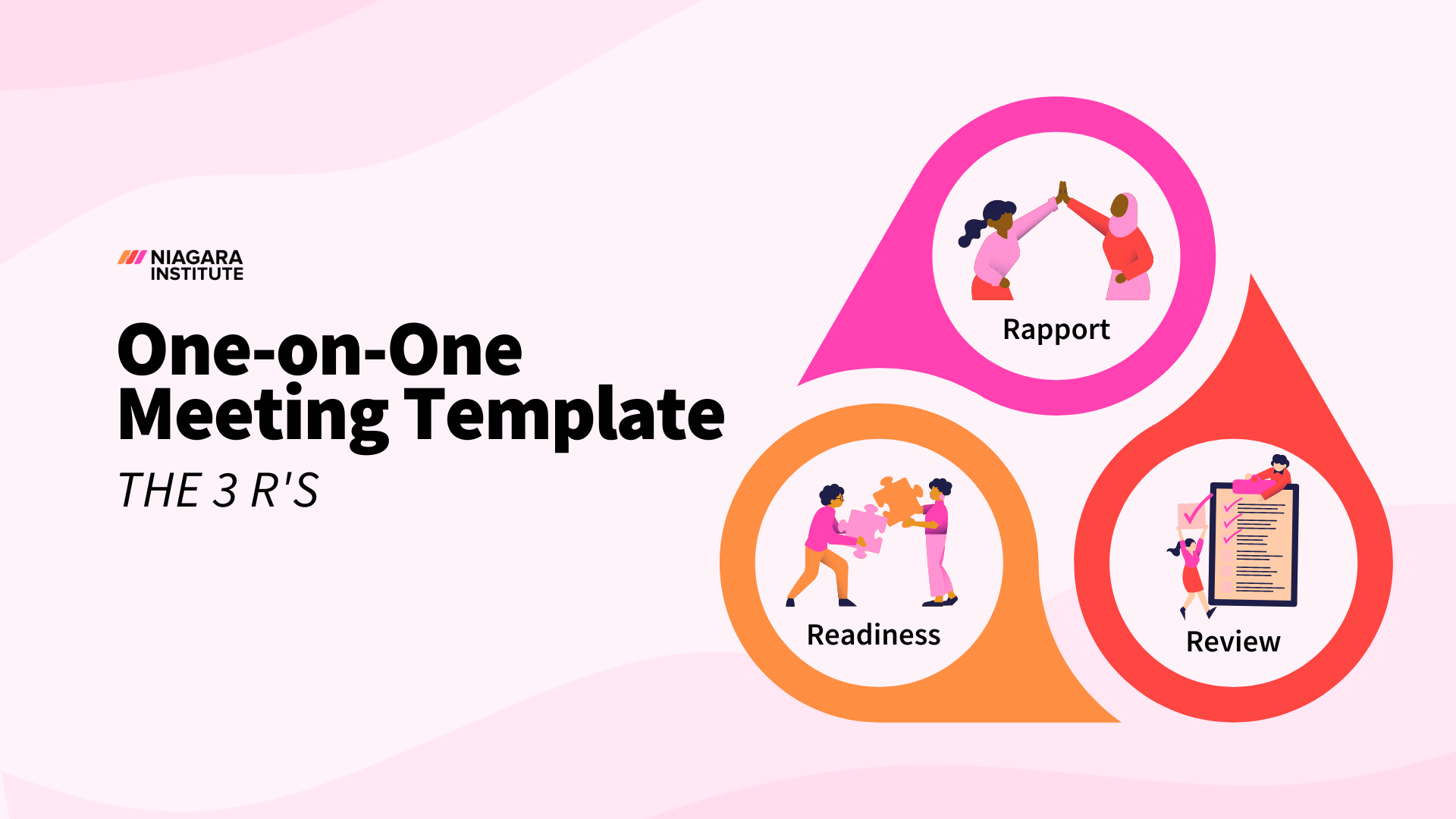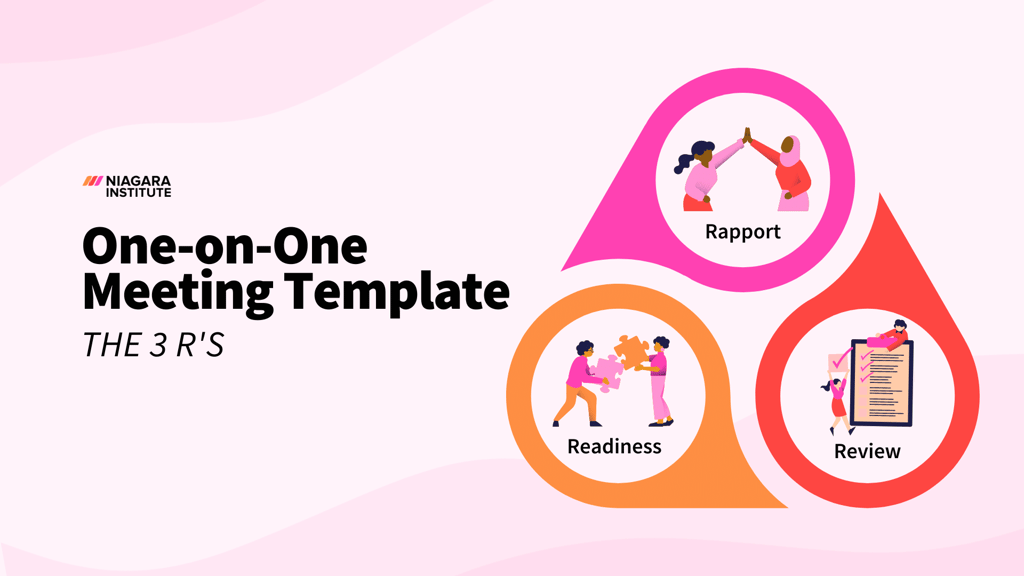8 min read
How To Prepare For a 1 on 1 Meeting (+Agenda Template)
No one should go into a one-on-one meeting unprepared. If you do, it can send a message to the person you’re meeting with that you don’t fully...
4 min read
 Michelle Bennett
:
Dec 7, 2023 5:00:00 AM
Michelle Bennett
:
Dec 7, 2023 5:00:00 AM

As a leader, the last thing you want an employee to think when you send an invite for a one-on-one meeting is, “What have I done wrong.” This can happen, though, if you treat this type of meeting as a report card of everything an employee has done right and wrong. It can also jeopardize the potential trust, credibility, and respect that can be built during one-on-ones and instead plant the seeds of fear, anxiety, and self-doubt.
Fortunately, you can avoid this by using the 3 R’s, a simple but highly effective one-on-one meeting template. The 3 R’s stand for Rapport, Review, and Readiness. It’s a 3-part one-on-one meeting formula that encourages you to take a balanced and holistic approach when meeting individually with each of your direct reports. Plus, it can be utilized regardless of whether your one-on-one meetings are 15 minutes, 30 minutes, or an hour long.
First and foremost, let’s start with a refresher on exactly what the intended purpose of a one-on-one meeting is in the workplace.
The purpose of a one-on-one meeting is for leaders to meet with their direct reports regularly to connect with them on a personal level, receive progress updates, offer support or guidance, discuss career goals, and provide timely coaching.
As one author for Harvard Business Review reminds us, “The best leaders recognize that one-on-ones are not an add-on to their role - they are foundational to it. Those who fully embrace these meetings as the place where leadership happens can make their teams’ day-to-day output better and more efficient, build trust and psychological safety, and improve employees’ experiences, motivation, and engagement. The managers thrive in turn because their success is tied to the performance of those reporting to them.”
In other words, one-on-one meetings can significantly influence your success and your employees. To unlock the potential benefits, though, you must be committed to showing up on time every time, intentional about the questions you ask, prepared to capitalize on coachable moments, and willing/able to give your employees your full attention.
As mentioned previously, the 3 R’s One-on-One Meeting Template is comprised of three parts: Rapport, Review, and Readiness. The idea is to break up your one-on-ones into three equal parts. This means if your one-on-one meeting is 30 minutes long, you would spend 10 minutes on each one of the R’s. If your meeting is an hour in length, then you would spend 20 minutes on each. Here’s a breakdown of what to discuss in each of the three parts.

According to a Gartner study, 82% of employees say it’s important to be seen as a person at work, not just an employee, and yet only 45% believe their organization/leaders actually see them this way. While flexibility, personal growth, holistic well-being, and a shared sense of purpose are all needed to make employees feel this way, so are deeper connections.
Fortunately, you can create deeper connections by building rapport with your employees during the beginning portion of your one-on-one meetings. This one-on-one meeting template encourages you to spend the first third of your meeting connecting with your employees as people who have lives, responsibilities, worries, and interests outside of work. Then, as you get to know each other better, not only will you build mutual trust and respect, but you will over time, be able to pick up on verbal and nonverbal cues that indicate how your employee is doing.
To give you an idea of what to discuss during the Rapport section, here are a few questions to consider asking in the first third of your one-on-one:
The middle part of this one-on-one meeting template should be spent reviewing your employee’s current workload, priorities, goals, and challenges. In other words, this is when you will receive status updates on what they’re working on. To keep this tactical and administrative part of the meeting moving along, tell your employees upfront what you need them to prepare and bring to your one-on-one meetings.
To give you an idea of the types of questions you can ask during the review portion of a one-on-one, here are some example questions:
To close out your one-on-one meeting, spend the last third of your time together focused on more strategic, big-picture, and long-term topics. We call this section Readiness because it should be about getting an employee ready to take on their future, whatever that may be. As such, you may discuss their development goals, training opportunities, professional goals, or career plans.
Here is a list of example questions that you may ask during this part of the meeting. The goal here isn’t to get through all the questions in one sitting. Instead, select one or two questions that you can have a deep, meaningful conversation about.

8 min read
No one should go into a one-on-one meeting unprepared. If you do, it can send a message to the person you’re meeting with that you don’t fully...

5 min read
This week alone, over 55 million meetings will take place; unfortunately, research and surveys have suggested that anywhere between 30-50% of meetings

5 min read
In leadership, your schedule is packed, your workload is heavy, and everyone seems to need your attention. Unfortunately, all of this can make it...